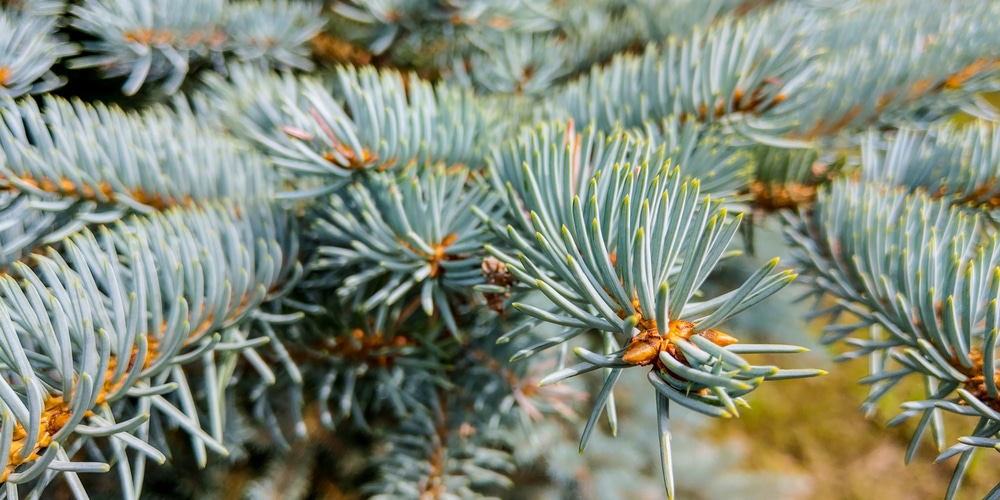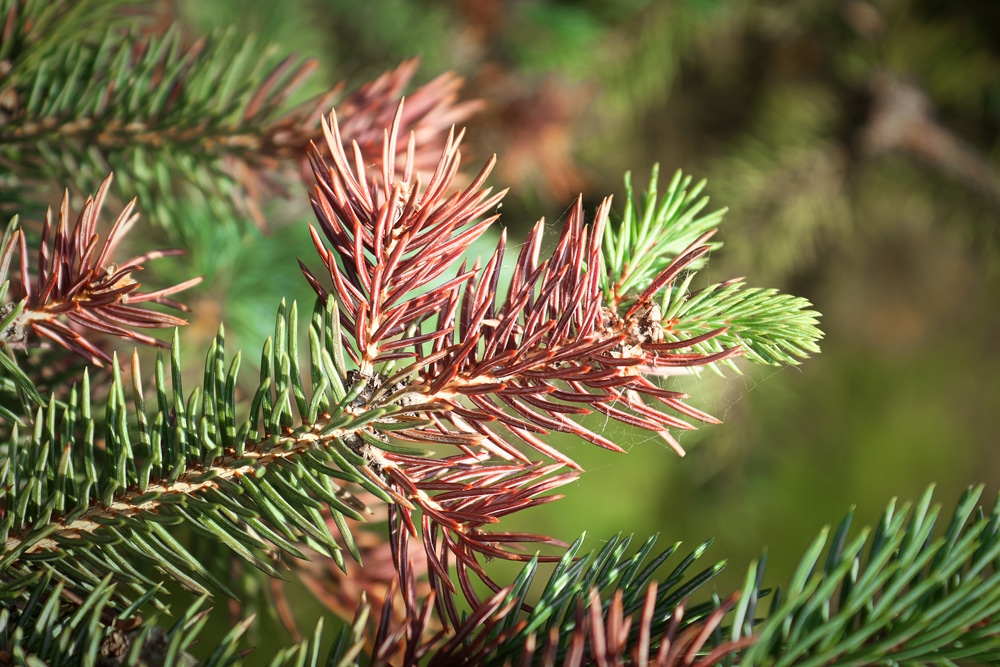Blue spruce trees make wonderful ornamental trees in a yard. But sadly, it’s common for diseases to strike them. So, below are the top reasons your blue spruce could show signs of decline and how to save a dying blue spruce.

1. Rhizosphaera Needle Cast Disease
Rhizosphaera needle cast disease is a fungus that causes blue spruce trees to lose their needles. You’ll notice the first signs of this fungus when the innermost needles on the lower branches of your spruce start to brown.
Needle cast is a common condition in this species and often occurs when the tree becomes stressed. Drought is one of the most significant stressors for this tree.
The Fix
It often takes a couple of years to reverse rhizosphaera needle cast disease in blue spruce trees.
But you can start by applying an anti-fungal treatment every three or four weeks when the needles emerge in the spring. Then, keep coating your tree in this medicine during wet periods. The fungus will eventually leave the plant and stay away for good.
2. Cytospora Canker Disease
Cytospora canker disease is yet another fungal infection in blue spruce trees. Signs that your blue spruce has cytospora canker disease include dead or dying branches randomly throughout the tree, particularly towards the bottom.
You may also notice that your blue spruce’s pine needles turn a purplish color and begin to fall. If you leave it untreated, cytospora canker disease will eventually kill your tree.
The Fix
Sadly, there isn’t a cure for cytospora canker disease in blue spruces. So, taking immediate action is vital to manage the fungus and prevent further growth.
Start by cutting away dead or dying branches during the dry season. Doing this during the dry season will prevent the cytospora canker spores from spreading. You can also apply a fungus treatment.
3. Needle Rust Disease
Another fungus that can kill blue spruce trees is needle rust disease. The condition gets its name because it causes a blue spruce’s needles to turn orange due to rust-colored spores that land on it.
But there’s a catch—the spores only become visible once the fungi blisters and opens, releasing its spores to spread more of itself.
The Fix
Fungal medication isn’t adequate for rust disease, given that the fungus has already spread its spores once you see the condition. So, it would help if you instead prune the most affected branches and cut down grass or bushes around your tree to improve the airflow.
The good news is that needle rust disease won’t kill your blue spruce, even though the tree appears unwell. Instead, if you’re lucky, it’s an aesthetic issue that will go away with time.
4. Poor Environmental Conditions
No matter how much work you put into preventing fungus from affecting your blue spruce tree, such care is no match for poor conditions in mother nature.
Blue spruce trees have deep roots to help them find water. But their feeder roots will begin to die in the event of excessive drought periods. Furthermore, drought weakens your blue spruce’s immunity, opening the opportunity to develop other diseases.
The Fix
If you notice that your blue spruce tree is beginning to look sparse and brittle during a drought, water it deeply once per week. You’ll want to ensure the soil remains soaked up to 15 inches deep.
Placing mulch around your blue spruce tree (but not right up against the trunk) is also vital for helping it retain moisture. Be sure to also water the soil well shortly before the first frost to help your tree have enough water to survive the winter.
Bring Your Blue Spruce Tree Back to Life
Determining the issue causing your blue spruce tree’s ill appearance can take trial and error. For example, injury from snow and winter weather can make your tree look like it’s dying in the spring when all it needs is a good pruning.
By being vigilant with your blue spruces and catching an issue early, you’ll have a greater chance of treating the problem and reviving your tree. When planting blue spruce trees ensure they are far enough apart to grow well.
